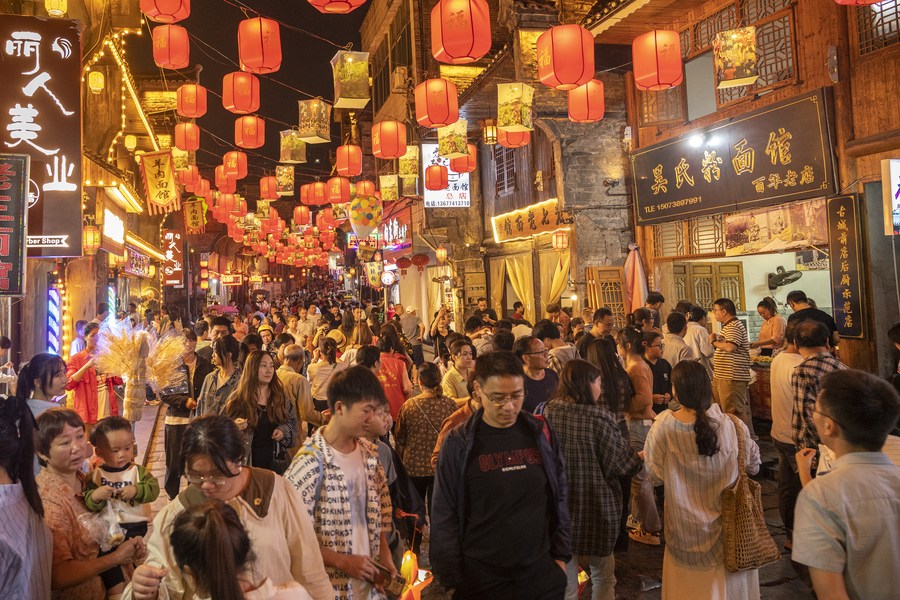
Tourists visit Xiangdong Street of Xinhua County, central China's Hunan Province, Oct. 2, 2023. (Photo by Wu Yonghua/Xinhua)
BEIJING, Oct. 8 (Xinhua) -- Beneath the warm autumn sun, expansive mountains roll out with camel caravans and tourists extending for miles at the Yueya Spring scenic spot in the city of Dunhuang, northwest China's Gansu Province.
According to statistics from the municipal department of culture and tourism, over the eight-day holiday that ended on Friday, Dunhuang welcomed 667,700 tourists, marking an increase of over tenfold compared to the previous year.
"Approximately 200,000 tourists experienced the beauty of the northwestern landscape in the Mingsha Mountain and the Yueya Spring, a crescent-shaped lake surrounded by giant sand dunes," said Wang Youxia, deputy general manager of Dunhuang Mingsha Mountain and Yueya Spring Tourism Development Co., Ltd.
The eight-day holiday, featured by the unique alignment of the Mid-Autumn Festival and the National Day holiday this year, fostered a vibrant festive ambiance. It unleashed people's enthusiasm for travel and reflects China's economic vitality.
SWARMS OF TOURISTS
A daily average of 57.28 million passenger trips were made during the holiday, surging 57.1 percent from the National Day holiday last year. From Sept. 29 to Oct. 6, the number of passenger trips came in at 458 million, the Ministry of Transport said Saturday.
During the holiday, Beijing hosted 11.88 million visitors, up 12.9 percent compared to 2019, according to the municipal culture and tourism bureau. The city's total tourism revenue during the period reached 15.57 billion yuan (2.16 billion U.S. dollars), doubling the number over last year and up 21.9 percent compared to the figures from 2019.
Northwest China's Xinjiang Uygur Autonomous Region has received over 15 million tourists during the holiday, an increase of 9.61 percent from the National Day holiday in 2019. The tourism revenue of the region reached 20.91 billion yuan, an increase of 7.86 percent compared with that of the 2019 National Day holiday, according to the regional culture and tourism department.
From Sept. 29 to 2 p.m. of Oct. 6, southwest China's Tibet Autonomous Region received 2.85 million tourists from home and abroad, with tourism revenue hitting 1.49 billion yuan. Both figures surpassed those registered during the Mid-Autumn Festival and National Day holiday in 2019.
HEATED CONSUMPTION
Popular attractions were bustling, central business districts saw surging sales, and blockbuster movies were released during the holiday period. Domestic tourism revenue soared to 753.43 billion yuan, and China's box office revenue during the holiday surpassed 2.7 billion yuan.
In Beijing, a total of 154 theaters hosted 2,017 performances, an average of 252 per day, attracting approximately 550,000 audience members and generating ticket sales of 90 million yuan.
The Wanfenglin scenic spot in southwest China's Guizhou Province enjoys immense popularity during the holiday. Li Hualiang, a 37-year-old marathon enthusiast, traveled from southern China's Guangdong Province to participate. "Here, you can revel in the splendor of nature and the exhilaration of sports," he said.
Statistics reveal that the Wanfenglin scenic spot welcomed over 239,000 tourists during the holiday, generating a cumulative revenue exceeding 50 million yuan.
In addition to major scenic spots, the duty-free shops in south China's island province of Hainan also benefited from the tourism spree. The capital city, Haikou, recorded total offshore duty-free sales of 1.33 billion yuan during the eight-day holiday, up 117 percent year on year, said the Haikou Customs. The number of duty-free customers reached 170,000, an increase of 143 percent over the same period in 2022.
"Holiday travel consumption has rebounded significantly, demonstrating the robust growth resilience of the Chinese economy and its promising development prospects," said Zhao Xijun, a finance professor at Renmin University of China.




 A single purchase
A single purchase









